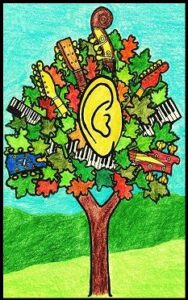 The scene in Peter Shaffer’s Oscar-winning film Amadeus, where Mozart is able to play by ear the march Salieri had written for him, after hearing it played only once, is fictional. But Mozart apparently did transcribe a complex choral arrangement by ear, illegally, after hearing it performed only once at a church in Rome. He went back and listened to it a second time to make sure he had transcribed it correctly. Many experienced musicians share this same basic ability. Mozart just possessed that ability to an extraordinary degree.
The scene in Peter Shaffer’s Oscar-winning film Amadeus, where Mozart is able to play by ear the march Salieri had written for him, after hearing it played only once, is fictional. But Mozart apparently did transcribe a complex choral arrangement by ear, illegally, after hearing it performed only once at a church in Rome. He went back and listened to it a second time to make sure he had transcribed it correctly. Many experienced musicians share this same basic ability. Mozart just possessed that ability to an extraordinary degree.
There is such a thing as “reading music by ear,” although if you search on that term, you might not find it anywhere. It’s a common practice with modern musicians, but for some reason it’s not a common term. “Reading music by ear” is completely different from the idea of “perfect pitch.” I’ll explain the difference later. For now, all you need to know is that you don’t need “perfect pitch” to play by ear, or to read music by ear.
“Reading music by ear” means reverse engineering instrumental parts based on what you hear, usually from a recording. It’s a maligned and misunderstood concept. There is a bias among those from the “classical school” against playing by ear. Many classical music students tell of how they hid their ability to pick out musical parts and play by ear because they feared criticism from fellow students, or from their teachers. As strange as that sounds, there are many personal anecdotes to that effect.
Like DNA, music contains within itself the instructions for its own reproduction. This is why an ear-trained musician with the right technical skills can exactly reproduce subtle nuances in the music they hear. If you’re a trained listener, then you can decode and reverse-engineer many types of music. You can even reverse-engineer the techniques they used to play the parts. On guitar, you can hear articulations like hammers, pulls, string-bends and slides. On piano, you can hear articulations like rolling-off the black keys, glissandos and sweeps. This allows you to make very exact reproductions of instrumental parts based solely on what you hear.
One way of learning to read music by ear is to follow a formal system. However, most musicians learn to read by ear intuitively, with no method or system. Most musicians are self-taught with regard to ear-training because there aren’t many places where you can learn it as part of a school program. Like rhythm training, reading by ear is a real-time activity, and can’t be taught effectively with written exercises.
Classical music programs for singers include sight-singing, and other forms of systematic ear-training. On the other hand, instrumentalists don’t usually get much ear-training in school. Students with good ear-training don’t have to fear transcription tests.
There’s no mystery to how people learn to play by ear. Contrary to what many people think, you don’t have to be an autistic, or artistic savant to play by ear. Let’s not turn this into anything more complicated than it is. We’re just talking about figuring out music by ear. You don’t have to “know” anything. You just try, and get the hang of it. The more of it you do, the better at it you get.
Reading by ear is the first step in playing by ear. Before you can play a song by ear, you have to decipher the music you intend to play. This can an individual or group project. This means you have to memorize the music as you “read.” Even if you write it down as you figure it out, your first step is to memorize what you read by ear in real time. We will see that confusion about the role of memory in music creates a lot of problems for musicians and teachers.
When you learn to read music by ear, you transform your relationship to your music collection. When you can read music by ear, your music collection becomes a reference library. (Every musician should own a collection of music, apart from streaming services.) More on this subject later.
It all goes to show the importance of learning to play music by ear.
2019, 2020 by Gregory Varhaug